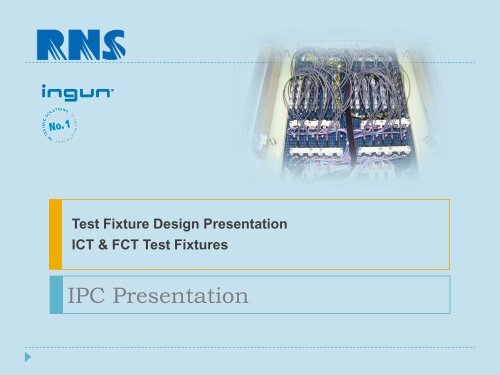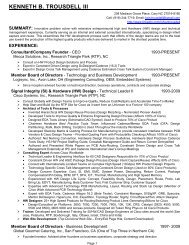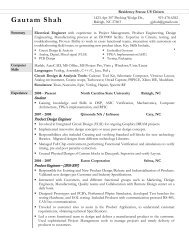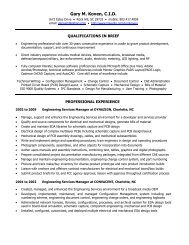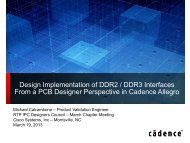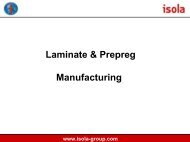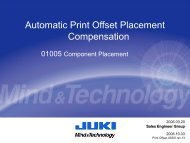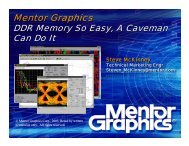Test Fixture Design Presentation - RTP Designers Council
Test Fixture Design Presentation - RTP Designers Council
Test Fixture Design Presentation - RTP Designers Council
You also want an ePaper? Increase the reach of your titles
YUMPU automatically turns print PDFs into web optimized ePapers that Google loves.
<strong>Test</strong> <strong>Fixture</strong> <strong>Design</strong> <strong>Presentation</strong><br />
ICT & FCT <strong>Test</strong> <strong>Fixture</strong>s<br />
IPC <strong>Presentation</strong>
Introduction<br />
Quality Control is essential in production processes. In the PCB Assembly process there are several Quality Control steps or<br />
options. The most popular tests are the electrical (In-Circuit or ICT) and the function (functional or FCT/FVT) test.<br />
ICT test fixtures are standardized and there are several major test platforms available which are industry standards.<br />
For FCT applications there are many more variations possible due to the vast number of testers and interface approaches<br />
unique to each customer; also due to an endless list of applications which fall under the category of Functional <strong>Test</strong> (RF,<br />
High Current, LED test, Leak test etc.)<br />
<strong>Test</strong> Probes are a very important part in ICT as well as in FCT applications. If the wrong test probe (type, spring force, tip style etc.) is<br />
used, the test fixture will not work as intended. In addition the test probe must be installed correctly in order to work properly.<br />
This presentation will show general information and some guidelines for a proper <strong>Test</strong> <strong>Fixture</strong> design to assure the most<br />
2<br />
efficient production.<br />
In-circuit <strong>Test</strong> for High Volume Production is nowadays almost 100% located in cheap-labor countries like China and Mexico. Only a<br />
few products are still made in the US and most times it is only Low Volume Production with a few exceptions.<br />
However, Functional <strong>Test</strong> has a larger market share in the US than ICT has. Some EMS Companies have their ICT equipment build in<br />
the USA and transferred to the appropriate manufacturing site located in Asia, Mexico etc.<br />
With this fact in mind, the existing ICT demand in the US market needs to be served professionally and in highest possible quality and<br />
cost efficiency.<br />
In the past 2 or 3 years FCT demand increased about 50% and at RNS the shares is about 65 : 35 (FCT : ICT).<br />
Functional applications are more time consuming and can be even higher in cost if more special components are involved like certain<br />
Electronic equipment or highly complex mechanical features. In the application sector FCT or FVT (Functional Verification <strong>Test</strong>) we<br />
include HiPot, RF (High Frequency), High Current, Leak <strong>Test</strong>, ISP Programming, <strong>Test</strong> Rack, Interconnect Solutions (Connector blocks<br />
…) etc., everything which is not 100% ICT falls under the category FCT/FVT.<br />
There is no clear answer if ICT or FCT is higher in cost. The most important fact is to rather spend some more dollars on a<br />
high quality test equipment for highest efficiency in PCB-Manufacturing than to just go with the cheapest price and have then<br />
a lot of down-times on the production line because of not proper working test equipment.<br />
www.rns-usa.com
Agenda<br />
1. Introduction<br />
2. <strong>Test</strong> Probes Basics – Terminology<br />
3. The most common Tip Styles<br />
4. <strong>Test</strong> Probes Life Expectancy<br />
5. Bead Probe Technology<br />
6. Aggressive Tip Styles<br />
7. Passive Tip Styles<br />
8. Common Question<br />
9. <strong>Fixture</strong> Overview<br />
10. <strong>Fixture</strong> Types<br />
11. ICT vs. FCT<br />
12. Hold Down Mechanism<br />
13. Difficulties in <strong>Fixture</strong> Manufacturing vs. Board <strong>Design</strong><br />
3<br />
www.rns-usa.com
The most common Tip Styles!<br />
Standard<br />
<strong>Test</strong> Probes<br />
* For Grid >25mil<br />
* More than 50<br />
different tip styles<br />
* Over 15.000<br />
variations in the<br />
individual series<br />
* Interface Probes<br />
for <strong>Test</strong> Systems<br />
* exclusive: e-type<br />
Probes (for ICT)<br />
5<br />
Switching<br />
Probes<br />
(SKS)<br />
Grids<br />
> 100 mil<br />
Reed-Probes<br />
(with Magnet)<br />
e.g. Tip Styles<br />
Rotating and<br />
Non-Rotating<br />
<strong>Test</strong> Probes<br />
Grids<br />
> 50 mil<br />
Threaded<br />
<strong>Test</strong> Probes<br />
Grids<br />
>50 mil<br />
Pneumatic<br />
Probes<br />
(PKS)<br />
Grids ><br />
75 mil<br />
Stroke up to<br />
20 mm<br />
High Current<br />
Probes<br />
(HSS)<br />
Grids ><br />
100 mil<br />
Currents up<br />
to 400 A<br />
High<br />
Frequency<br />
Probes (HFS)<br />
Grids<br />
> 100 mil<br />
Range up<br />
to 6 GHz.<br />
Impedance<br />
50 or 75 Ω
Bead Probe Technology<br />
Bead Probe Technology was invented by Agilent on demand of more and more density in Board<br />
Manufacturing. Solder beads are placed directly on traces (only on top layer traces possible) where<br />
the original test pad or point cannot be reached due to high density or component interference.<br />
In regards to test fixture manufacturing, nothing has to change because Bead Probes are handled<br />
just like regular ICT test probes.<br />
The biggest advantages are:<br />
- Larger test coverage<br />
- Lower fixture costs because of less smaller probe sizes (25, 40 and 50 mil)<br />
- <strong>Fixture</strong> Manufacturing does not require additional processes<br />
- Same receptacles as used for Standard Probes (GKS)<br />
Ingun has developed special tip-styles in close<br />
cooperation with global customers to be able to<br />
provide the ideal solution for the applicable Bead.<br />
Left: un-probed Bead Right: probed Bead<br />
8
Bead Probe Technology<br />
The choice of the ideal spring-Force in combination with the tip-style, which has already been<br />
chosen depending on the composition of the Beads (i.e. contamination / solder hardness) and the<br />
intended deformation of the Bead. spring forces from 1.0N (3.6 oz.) to 3.0N (10.8 oz.) are available.<br />
choice of Spring-force depending on the choice of Spring-force depending on<br />
type of contamination and flux-deposits: the hardness of the Solder:<br />
Examples:<br />
No Contamination / Flux-deposits:<br />
Contamination 1 (good)<br />
Soft, fluid-type Flux-deposits:<br />
Contamination 2 (middle)<br />
Hard, wax-type Flux-deposits:<br />
Contamination 3 (bad)<br />
9<br />
Examples:<br />
SN 63 = 12.8 HV: Hardness 1 (soft)<br />
SAC 305 = 17.7 HV: Hardness 2 (middle)<br />
Innolot = 33.6 HV: Hardness 3 (hard)
Aggressive Tip Styles (91 - Dagger)<br />
Tip Style 91 (Dagger)<br />
The solution to most contacting problems<br />
• aggressive Steel Tip<br />
• ground edges<br />
• high life-expectancy<br />
• similar alternatives available, see tip-styles 77 & 97<br />
For every application, the matching tip-style<br />
Tip-Style 91<br />
Dagger, aggressive,<br />
2 contacting edges:<br />
• for highly<br />
contaminated PCB‘s<br />
10<br />
Tip-Style 97 Tip-Style 77<br />
Dagger, more passive, but also<br />
more robust. 2 contacting edges:<br />
• for closed/sealed via<br />
(i.e. lacquer) -see above!<br />
• for less-contaminated PCB‘s<br />
Dagger, aggressive,<br />
more robust:<br />
3 contacting edges,<br />
• for demanding<br />
high-volume production<br />
Area of Usage:<br />
• highly contaminated PCB‘s<br />
• for open or closed/sealed vias<br />
• universal usage possible
Alternative to 91<br />
Alternatives to Tip Style 91<br />
Sealing Lacquer prevents<br />
good contact of the flanks of<br />
the tips 77 and 91, i.e. the<br />
tip digs into the Lacquer<br />
Possibility that the<br />
Sealing Lacquer is<br />
punctured<br />
11<br />
Tip Style 97<br />
Tip Angle 40° Tip Angle 90°<br />
Tip Style 98<br />
• Tip Angle ~ 150°<br />
• Equivalent to<br />
QA tip-style 61 (Blade)
Aggressive Tip 14 & 09<br />
Tip Style 14<br />
4-point crown<br />
self-cleaning<br />
12<br />
• very aggressive<br />
• for component pins<br />
Tip Style 09<br />
Flexible Needle<br />
• high Stability<br />
and Flexibility
Passive Tip 08 & 06<br />
90 º Conical Tip • for less-critical<br />
applications<br />
(i.e. Connectors)<br />
13<br />
Tip Style 08<br />
Serrated Tip<br />
Tip Style 06<br />
• universal applications,<br />
but prone to<br />
contamination
Passive Tip 03 & 05<br />
Tip Style 03<br />
90° Inverse Cone<br />
14<br />
• self-registration<br />
• for Connector Pins<br />
• tends to contaminate<br />
Bullet-nose Tip<br />
Tip Style 05<br />
• very passive<br />
• for less-critical<br />
applications
Common Question<br />
Question:<br />
What are the guidelines for the probe hole size?<br />
Answer:<br />
The Hole-ø and Drill-ø depends on:<br />
Probe Plate Material (e.g. CEM1, FR4, Delrin etc.)<br />
Feed of drill<br />
Speed of drill<br />
Grid (smaller holes are critical)<br />
Quality of the Drilling Machine<br />
Quality of the drill bit<br />
For standard series INGUN have laid down drilling parameters for CEM1 und FR4<br />
materials, however, sample drilling is unavoidable!<br />
At RNS specific drill procedures and state-of-the-art CNC drill equipment assures<br />
highest accuracy even on 50, 40 and 25 Mil test probes.<br />
15
<strong>Fixture</strong> Overview<br />
7<br />
12<br />
19<br />
16<br />
2<br />
1<br />
17<br />
10<br />
15<br />
8<br />
4<br />
6<br />
3<br />
5<br />
14<br />
11 13 16<br />
9<br />
18<br />
ID Component Name<br />
1 Cover<br />
2 Backer Gate Frame<br />
3 Push Plate<br />
4 Push Tees<br />
5 PCB (UUT)<br />
6 Standoff (Board Stop)<br />
7 Top Plate<br />
8 Registration Pin<br />
9 Probe Plate Rail<br />
10 Probe Support Plate<br />
11 Probe Plate<br />
12 Vacuum Dam<br />
13 Support Plate<br />
14 Ground Plane<br />
15 <strong>Test</strong> Probes / Receptacles<br />
16 Vacuum Port<br />
17 <strong>Fixture</strong> Pan<br />
18 Interface cutout<br />
19 Counter<br />
www.rns-usa.com
<strong>Fixture</strong> Types<br />
The industry uses several standard tester platforms<br />
HP307x, GenRad 227x, Zenthel, Spectrum …<br />
Most common <strong>Fixture</strong> actuations<br />
Vacuum: In ICT application Vacuum actuation is the most used technic<br />
Pneumatic: For fixtures with a very large amount of probes pneumatic actuation is used.<br />
Mechanical: Mostly used in Functional applications.<br />
Most common hold-down mechanisms or <strong>Fixture</strong> Types are<br />
Backer Gate<br />
Vacuum Cover (Box)<br />
ZSK – Clamshell<br />
Mechanical/Linear <strong>Fixture</strong><br />
Wired and Wireless (no wires) <strong>Fixture</strong>s<br />
17<br />
Traditional ICT <strong>Fixture</strong>s are wired from <strong>Test</strong> Probes to the Interface Panel.<br />
Sometimes a ICT <strong>Fixture</strong> is required in Wireless-Technology which means no wires are involved for<br />
transferring signals from the test points to the <strong>Test</strong>er. In this case there are double-ended test probes<br />
utilized in conjunction with a Transfer Board or Translator Board. The fixture stack-up is different to a<br />
traditionally wired fixture. There is no fixture pan involved like with a wired fixture.<br />
www.rns-usa.com
ICT vs. FCT<br />
ICT is board level test (component placement and value)<br />
18<br />
Lot of test probes<br />
Most board failures can be repaired<br />
In-circuit <strong>Test</strong> detects:<br />
Missing components<br />
Disorientation of components<br />
Improper value<br />
FCT is a functional test (performance test)<br />
Less test probes<br />
After board assembly is completed<br />
If performed without ICT, board failures can result in loss of complete assembly<br />
www.rns-usa.com
Hold-Down Mechanism<br />
Backer Gate<br />
Mechanical hold-down but with vacuum actuation. Only for<br />
bottom test points. In some events it is possible to have<br />
test probes contacting on the top side of the PCB (this has<br />
to be carefully determined). UUT can be accessed during<br />
test.<br />
Vacuum Cover (Box)<br />
Bottom and top side of PCB is enclosed in vacuum. No<br />
UUT access during test.<br />
ZSK - Clamshell<br />
The same as a Vacuum Box <strong>Fixture</strong> but with probes<br />
contacting top & bottom side test points. No access to the<br />
UUT during test.<br />
Mechanical / Linear <strong>Fixture</strong><br />
The same type as the Backer Gate but with linear motion<br />
and actuation is 100% manual.<br />
Number of test probes allowed to use is depending on<br />
spring force of test probes.<br />
19<br />
www.rns-usa.com
Difficulties in <strong>Fixture</strong> Manufacturing<br />
vs. Board <strong>Design</strong><br />
The most challenging part for a fixture manufacturer is to provide a reliable and good contact at all time.<br />
Several factors are playing a role to achieve this goal. If testability is already taken into account when the<br />
board is in design stage often several obstacles can be avoided or eliminated.<br />
In order to provide a reliable test for board production a board design needs:<br />
1. As close as possible 100% accessibility to test points<br />
a) <strong>Test</strong> point covered by component, bracket, heat sink, cover etc.<br />
2. Enough test point clearance to components to assure guided probe technology.<br />
a) Some components require milling into the top plate<br />
b)<br />
3. <strong>Test</strong> pads as large as possible<br />
4. Enough space on board to place board standoffs (board stops) on top plate<br />
5. Enough space on board to place push tees/rods on top side of the board<br />
6. Contact issues (test points) can occur because of:<br />
20<br />
Probe Series (spacing) Distances (inch)<br />
040 Mil 0.035<br />
050 Mil 0.035<br />
075 Mil 0.045<br />
100 Mil 0.055<br />
a) <strong>Test</strong> Probe not guided (Guide holes can be eliminated through extensive routing for components)<br />
b) Solder flux, Dirty environment<br />
www.rns-usa.com
ICT <strong>Test</strong> <strong>Fixture</strong>s<br />
21<br />
www.rns-usa.com
ICT <strong>Test</strong> <strong>Fixture</strong>s<br />
<strong>Test</strong> Points <strong>Fixture</strong> Kit Size<br />
Total: 4417<br />
100 Mil: 2306<br />
075 Mil: 1076<br />
050 Mil: 1035<br />
040 Mil: 32<br />
22<br />
28 x 30 x 6 inch<br />
Single Well<br />
Turn Time:<br />
14 – 18 days<br />
GenRad ICT<br />
Pneumatic<br />
www.rns-usa.com
ICT <strong>Test</strong> <strong>Fixture</strong>s<br />
<strong>Test</strong> Points Features<br />
Total: 718<br />
100 Mil: 168<br />
075 Mil: 159<br />
050 Mil: 285<br />
040 Mil: 48<br />
025 Mil: 58<br />
23<br />
Top and Bottom <strong>Test</strong><br />
With ZSK-Clamshell<br />
Genrad ICT<br />
20 x 16 x 3.5”<br />
Turn Time:<br />
8 – 10 days<br />
www.rns-usa.com
ICT <strong>Test</strong> <strong>Fixture</strong>s<br />
<strong>Test</strong> Points <strong>Fixture</strong> Kit Size<br />
Total: 4417<br />
100 Mil: 2306<br />
075 Mil: 1076<br />
050 Mil: 1035<br />
040 Mil: 32<br />
24<br />
28 x 30 x 6 inch<br />
Single Well<br />
Turn Time:<br />
14 – 18 days<br />
GenRad ICT<br />
Pneumatic<br />
www.rns-usa.com
ICT <strong>Test</strong> <strong>Fixture</strong>s<br />
<strong>Test</strong> Points Features<br />
Total: 1456<br />
100 Mil: 1006<br />
075 Mil: 450<br />
050 Mil:<br />
25<br />
Pneumatic Top Access Unit<br />
Pneumatic Side Access Unit<br />
GenRad ICT<br />
24 x 30<br />
Vacuum Cover<br />
Turn Time:<br />
15 – 17 days<br />
www.rns-usa.com
ICT <strong>Test</strong> <strong>Fixture</strong>s<br />
26<br />
20 x 16 GenRad <strong>Fixture</strong> with Backer Gate<br />
www.rns-usa.com
ICT <strong>Test</strong> <strong>Fixture</strong>s<br />
<strong>Test</strong> Points Features<br />
Total: 3658<br />
100 Mil: 134<br />
075 Mil: 379<br />
050 Mil: 1141<br />
040 Mil: 1305<br />
025 Mil: 174<br />
27<br />
(1) Pneumatic SAU<br />
(2) Mechanical SAU<br />
(9) Cooling Fans<br />
(7) LED Sensors<br />
(5) Super Conn<br />
FEA Board Stress<br />
Strain Gauge<br />
Genrad ICT<br />
24x30<br />
Backer Gate<br />
Turn Time:<br />
20 – 25 days<br />
www.rns-usa.com
ICT <strong>Test</strong> <strong>Fixture</strong>s<br />
<strong>Test</strong> Points Features<br />
Total: 800<br />
100 Mil: 66<br />
075 Mil: 106<br />
050 Mil: 612<br />
28<br />
Top and Bottom <strong>Test</strong><br />
(3) OFM<br />
Pneumatic Probes<br />
Genrad 227X L<br />
20x30 ICT<br />
ZSK Clamshell<br />
Turn Time:<br />
9 – 11 days<br />
www.rns-usa.com
ICT <strong>Test</strong> <strong>Fixture</strong>s<br />
<strong>Test</strong> Points <strong>Fixture</strong> Kit Size Board Size:<br />
18 x 23”<br />
(457.20 x 584.20 mm)<br />
Total: 9162<br />
100 Mil: 1979<br />
075 Mil: 3504<br />
050 Mil: 3074<br />
040 Mil: 605<br />
29<br />
Wireless 24 x 30<br />
Pneumatic Side Access<br />
BGA Cage Blocks<br />
Cooling Fans<br />
Power Supply<br />
GenRad ICT<br />
Vacuum Cover<br />
Turn Time:<br />
15 – 17 days<br />
www.rns-usa.com
ICT <strong>Test</strong> <strong>Fixture</strong>s<br />
<strong>Test</strong> Points<br />
Total: 740<br />
100 Mil: 740<br />
075 Mil:<br />
050 Mil:<br />
040 Mil:<br />
30<br />
<strong>Fixture</strong> Kit Size<br />
HP Small<br />
Personality 800<br />
Board Marker (5)<br />
ISP Programmer (1)<br />
HP307X ICT<br />
Vacuum Cover<br />
Turn Time:<br />
7 – 9 days<br />
www.rns-usa.com
ICT <strong>Test</strong> <strong>Fixture</strong>s<br />
<strong>Test</strong> Points <strong>Fixture</strong> Kit Size<br />
Total: 580<br />
100 Mil: 460<br />
075 Mil: 100<br />
050 Mil: 20<br />
040 Mil:<br />
31<br />
HP Small<br />
Personality 600<br />
Board Marker (10)<br />
Trident LED Sensors (20)<br />
for (60 ) LEDs<br />
<strong>Test</strong>Jet (10)<br />
Infrared Sensor (2)<br />
HP307X ICT<br />
Vacuum Cover<br />
Turn Time:<br />
7 – 9 days<br />
www.rns-usa.com
ICT <strong>Test</strong> <strong>Fixture</strong>s<br />
32<br />
www.rns-usa.com
FCT - Functional <strong>Test</strong> <strong>Fixture</strong>s<br />
FCT- <strong>Test</strong> Rack (for Cognex camera system) showing the opened<br />
<strong>Test</strong> <strong>Fixture</strong> for the LED Board.<br />
Challenge here is to provide a reliable and save hold-down solution<br />
without covering any LED.<br />
Each LED has to be detected by the Vision System (Camera) on the<br />
top.<br />
Solution is having a “push tee” across the entire board (DUT) and is<br />
accommodated with Delrin and G10 plate with proper cut-outs for<br />
LEDs and other components.<br />
33<br />
Functional <strong>Test</strong> Rack incl. Camera Stand (for Cognex<br />
Camera System) and Virginia Panel G2 Receiver<br />
Project:<br />
Automotive<br />
Application:<br />
LED <strong>Test</strong> of Rear Light<br />
Left and Right<br />
(1) <strong>Test</strong> Stand (Rack)<br />
(2) Debug <strong>Fixture</strong><br />
(2) Production <strong>Fixture</strong><br />
Turn Time:<br />
7 – 9 days<br />
www.rns-usa.com
FCT - Functional <strong>Test</strong> <strong>Fixture</strong>s<br />
34<br />
Functional <strong>Test</strong> <strong>Fixture</strong> with interchangeable nest<br />
Project:<br />
Automotive<br />
Application:<br />
High Current Measurement<br />
Pneumatic actuation<br />
(1) Production <strong>Fixture</strong><br />
(2) Interchangeable Nest<br />
(3) Reject Chute for test<br />
rack<br />
Turn Time:<br />
10 – 15 days<br />
www.rns-usa.com
FCT - Functional <strong>Test</strong> <strong>Fixture</strong>s<br />
Functional <strong>Test</strong> <strong>Fixture</strong><br />
Project:<br />
Automotive<br />
35<br />
Automatic Gate Turn Time:<br />
7 – 12 days<br />
www.rns-usa.com
FCT - Functional <strong>Test</strong> <strong>Fixture</strong>s<br />
Functional <strong>Test</strong> <strong>Fixture</strong>s with Linear Mechanical Gate<br />
Project:<br />
Agilent Card Cages<br />
36<br />
Application:<br />
Back panel Multiple <strong>Test</strong><br />
(2) Card Cages<br />
Turn Time:<br />
7– 9 days<br />
www.rns-usa.com
FCT - Functional <strong>Test</strong> <strong>Fixture</strong>s<br />
Honeywell (top)<br />
Project:<br />
Honeywell<br />
OSRAM (bottom right)<br />
Project:<br />
Osram LED<br />
37<br />
Application:<br />
PXI Receiver<br />
Application:<br />
FCT (Functional <strong>Test</strong>)<br />
for LED Illumination<br />
Product<br />
Turn Time:<br />
7– 10 days<br />
Turn Time:<br />
7– 10 days<br />
www.rns-usa.com
Vocabulary<br />
Term Description<br />
<strong>Fixture</strong> Kit A complete kit consists a fixture pan, probe plate, support plate, top plate, hold-down unit, gas shocks, handles,<br />
cycle counter<br />
<strong>Fixture</strong> Pan Is the base of a fixture and holds the interface and wires. Also additional test instruments are usually placed inside<br />
the fixture pan as well as the <strong>Fixture</strong> label which shows the BOM for <strong>Test</strong> Probes, Serial Number and Date of<br />
completion.<br />
Top Plate Here the stand offs are placed and the tooling pins to key the UUT to the fixture. Usually a X,Y grid is silkscreened<br />
for easy nail number location. The Top Plate is always ESD safe. It has a “Guided Hole” for test probes which<br />
assures the accuracy for targeting.<br />
Guide Plate This plate will help with guiding the test probe reliably to the target (test point etc.)<br />
Probe Plate Here all the receptacles are installed which are holding the test probes. Today 100, 75, 50, 40 and 25 Mil spacing<br />
is common.<br />
Support Plate This plate helps to make the fixture more sturdy and prevents it from bowing.<br />
Push Plate Push Tees are installed in this plate. They help to keep the UUT flat under test.<br />
<strong>Test</strong> Probes These are spring-loaded pins which contact the test points on the UUT.<br />
Marker Probe When a board passes or fails test then sometimes a marker probe is used to mark the Board-Assembly with a<br />
circle.<br />
Interface Panel The interconnection between the <strong>Test</strong> <strong>Fixture</strong> and the <strong>Test</strong>er<br />
OFM, <strong>Test</strong> Jet,<br />
FrameScan<br />
<strong>Test</strong> Feature for Polarity Check or Existence<br />
Mux Card Circuit Board to transfer the OFM / <strong>Test</strong>Jet / Framescan signals to the interface<br />
Backer Gate Mechanical Hold-Down Unit<br />
Vacuum Cover Vacuum Hold-Down Unit<br />
38 www.rns-usa.com
Vocabulary<br />
Term Description<br />
Standoff Board stops where the UUT rests on. 0.050, 0.060 and 0.080 inch height<br />
Gasket Seals up the vacuum area in the fixture<br />
Registration Pin Mates together with the Bushing to make sure that all plates in a fixture are ligned up to each other.<br />
Tooling Pin The tooling Pin (most times 3) register the UUT to the fixture.<br />
Personality Pin These Pins are used in HP3070 <strong>Fixture</strong>s as transfer pins for the probe signals<br />
Transfer Pin These are solid gold-plated pins which transfers signals, most times from the top to the bottom.<br />
Gerber Files PCB design package. These files are needed for fixture design<br />
Drill File This is the file which makes sure that every single test probe will hit the right test point on the UUT, if 100, 75, 50,<br />
40 or 25 Mil<br />
Wire File The Wiring department of course needs appropriate instructions to wire the test probes to the correct interface<br />
location. On FCT fixtures wiring is more versatile and not that much automated as on ICT applications.<br />
UUT, DUT UUT= Unit Under <strong>Test</strong> / DUT= Device Under <strong>Test</strong><br />
Loaded Board PCB which is assembled, also called Board Assembly<br />
ZSK Vacuum Hold-Down for top side testing<br />
Pneumatic actuation <strong>Fixture</strong> actuated with air cylinder<br />
Bushing Bushing for the Registration Pin<br />
Push Tees Installed in Push Plate (Backer Gate), VAC Plate (Vacuum Cover), Guide Plate (ZSK). They are responsible to<br />
keep the UUT flat under test.<br />
39 www.rns-usa.com
Vocabulary<br />
Term Description<br />
FEA Finite Element Analysis. CAD based Stress analysis which shows spots where large stress is created on the UUT<br />
under test.<br />
Strain Gauge This is the physical stress measurement where a board assembly will be used.<br />
SAU Side Access Unit. Used for contacting connectors etc. from the side<br />
TAU Top Access Unit. Same as SAU only coming from the top. From the Bottom it would be BAU.<br />
Translator board Is used on Wireless fixtures to transfer the signals through double-ended probes to the <strong>Test</strong>er.<br />
Is also called Interface board.<br />
Aluma Lift Very common brand for <strong>Fixture</strong> handles, which are standard in the ATE Industry<br />
ICT In-circuit <strong>Test</strong><br />
FCT or FVT Functional <strong>Test</strong> or Functional Verification <strong>Test</strong><br />
40 www.rns-usa.com
More Information<br />
Also see <strong>Fixture</strong> References for example projects (see CD)<br />
www.rns-usa.com/cms<br />
For Technical questions and Support please contact:<br />
Greg Dorsey: greg.dorsey@rns-usa.com<br />
Sven F. Nocher: sven.nocher@rns-usa.com<br />
<strong>Test</strong> Equipment ICT/FCT • <strong>Test</strong> Probes • Interconnect Solutions<br />
ISP Programming • LED Digital Analyzer • Color Sensors<br />
<strong>Test</strong> Plugs • Engineering Services<br />
Precision CNC Machining • Assembly Services<br />
RNS International, Inc.<br />
5001 Sirus Lane Ph (704) 329 0444 sales@rns-usa.com<br />
Charlotte, NC 28208 Fax (704) 329 0404 sven.nocher@rns-usa.com<br />
www.rns-usa.com<br />
41<br />
www.rns-usa.com


